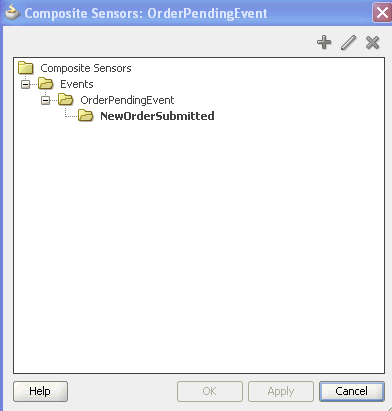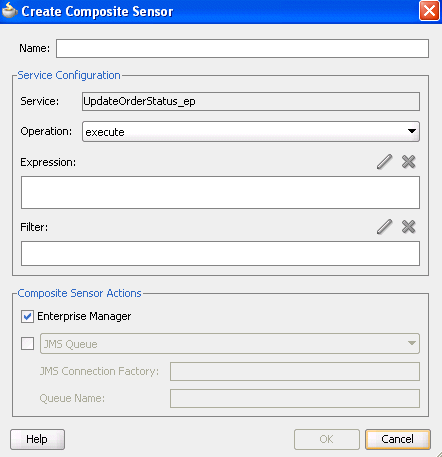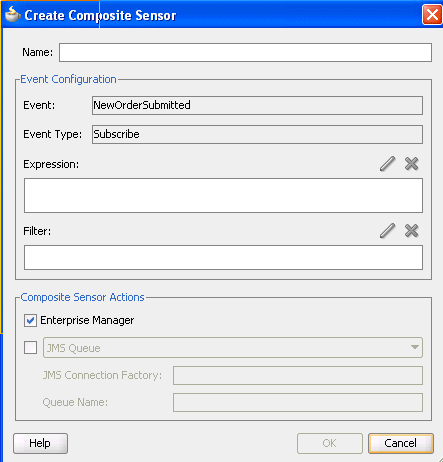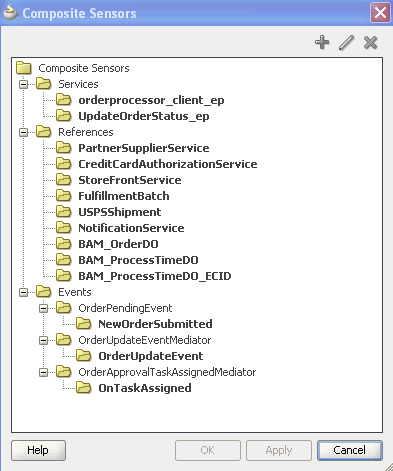How to Add Composite Sensors
To add composite sensors:
-
Use one of the following options to add a composite sensor in the SOA Composite Editor:
- Option 1:
-
Right-click a specific service or reference binding component in the Exposed Services or External References swimlane or a service component that has a subscribed business event. A service component that has a subscribed business event includes the word Subscribed on it.
-
Select Configure Sensors.
Note:
The service component must already have a subscribed business event for the Configure Sensors option to be displayed.
If you selected a binding component, the Composite Sensors dialog displays the details shown in Figure 54-1. For this example, a service binding component is selected.
Figure 54-1 Composite Sensors Dialog for the Selected Binding Component

Description of "Figure 54-1 Composite Sensors Dialog for the Selected Binding Component"If you selected a service component, the Composite Sensors dialog displays the details shown in Figure 54-2.
Figure 54-2 Composite Sensors Dialog for the Selected Service Component

Description of "Figure 54-2 Composite Sensors Dialog for the Selected Service Component" -
Select the binding component or service component in the dialog, and click the Add icon.
-
- Option 2:
-
Click the Composite Sensor icon above the SOA Composite Editor, as shown in Figure 54-3.
The Composite Sensors dialog for the SOA composite application appears, as shown in Figure 54-4. This option displays all the service and reference binding components and service components with subscribed business events in the SOA composite application.
-
Select the specific service, reference, or business event to which to add a composite sensor, then click the Add icon.
-
If you selected a binding component such as a service, the Create Composite Sensor dialog appears as shown in Figure 54-5.
Figure 54-5 Create Composite Sensor Dialog for a Service Binding Component

Description of "Figure 54-5 Create Composite Sensor Dialog for a Service Binding Component"If you selected a service component that has a business event subscription, the Create Composite Sensor dialog appears as shown in Figure 54-6.
Figure 54-6 Create Composite Sensor Dialog for a Service Component

Description of "Figure 54-6 Create Composite Sensor Dialog for a Service Component" - Option 1:
-
Enter the details shown in Table 54-1.
Table 54-1 Create Composite Sensor Dialog
Name Description Name
Enter a name for the composite sensor. You must enter a name to enable the Edit icon of the Expression field.
Service
Displays the name of the service. This field is only displayed if you are creating a composite sensor for a service binding component. This field cannot be edited.
Service sensors monitor the messages that the service receives from the external world or from another composite application.
Reference
Displays the name of the reference. This field is only displayed if you are creating a composite sensor for a reference binding component. This field cannot be edited.
Reference sensors monitor the messages that the reference sends to the external world or to another composite application.
Operation
Select the operation for the port type of the service or reference. This field only displays for service or reference binding components.
Event
Displays the name of the service component. This field is only displayed if you are creating a composite sensor for a service component. This field cannot be edited.
Event sensors track composite instances initiated through a business event. You can create multiple sensors per business event.
Event Type
Displays the Subscribe business event type. This field cannot be edited. The publish business event type is not supported.
Expression
Click the Edit icon to display a dropdown list for selecting the type of expression to create:
-
Variables: Select to create an expression value for a variable. See How to Add a Variable.
-
Expression: Select to open the Expression Builder dialog for creating an XPath expression. This action always captures values as strings. See How to Add an Expression.
-
Properties: Select to create an expression value for a normalized message header property. These are the same properties that display under the Properties tab of the invoke activity, receive activity, reply activity, OnEvent branch of a scope activity (in BPEL 2.0), and OnMessage branch of a pick activity and scope activity (in BPEL 2.0). See How to Add a Property.
Filter
Click the Edit icon to open the Expression Builder dialog to create an XPath filter for the expression. You must first create an expression to enable this field.
For example, you may create an expression for tracking purchase order amounts over
10,000:$in.inDict/tns:inDict/ns2:KeyValueOfstringstring/ns2:Value > 10000.00
Composite Sensor Actions
Displays the supported sensor actions. This feature enables you to store runtime sensor data. You can select both Enterprise Manager and either JMS Queue or JMS Topic.
-
Enterprise Manager
Select to make runtime sensor data searchable in the Flow Instances tab of a SOA composite application in Oracle Enterprise Manager Fusion Middleware Control. This selection is the same as the DBSensorAction selection of previous releases.
Note: When Enterprise Manager is selected, sensor data is sent to the trackable fields tables. When it is not selected, data is not sent. However, in both cases, Oracle Enterprise Manager Fusion Middleware Control still displays the fields that enable you to search for composite instances based on that sensor.
For more information, see Administering Oracle SOA Suite and Oracle Business Process Management Suite.
-
JMS Queue
Select to store composite sensor data (XML payload) in a JMS queue. You must specify the JMS connection factory and queue name.
-
JMS Topic
Select to store composite sensor data (XML payload) in a JMS topic. You must specify the JMS connection factory and topic name.
Notes: The JMS Queue and JMS Topic selections enable the composite sensor data (XML payload) to be used by other consumers, including Oracle Business Activity Monitoring (BAM) and Oracle Complex Event Processing. Both selections use the native JMS support provided with Oracle WebLogic Server, and not the Oracle SOA Suite JMS adapter described in Understanding Technology Adapters. You can view JMS messages in the Oracle WebLogic Remote Console.
-
-
Click OK.
For a service or reference binding component, a composite sensor icon displays in the upper right corner, as shown in Figure 54-7.
Figure 54-7 Sensor Icon on Binding Component

Description of "Figure 54-7 Sensor Icon on Binding Component"For a service component, a composite sensor icon also displays in the upper right corner, as shown in Figure 54-8.
Figure 54-8 Sensor Icon on Service Component

Description of "Figure 54-8 Sensor Icon on Service Component" -
Place your cursor over the composite sensor icon to display details about the composite sensor.
